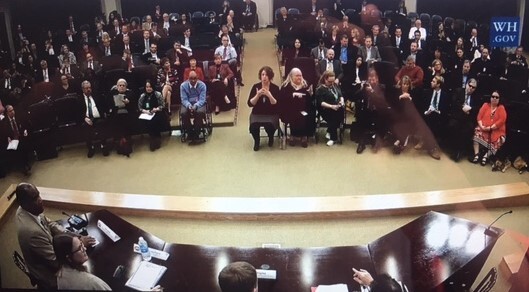White House Disability & Inclusive Technology Summit
Summit auditorium (photo credits: White House stream, Dana Marlowe)
This Monday 7 November 2016, I had the honor of attending the White House Disability & Inclusive Technology Summit. It was a great event, involving representatives of the disability community, research, industry, government, and other experts.
One main topic was the Internet of Things (IoT), and the incredible opportunity it could provide for people with disabilities - for example by making "smart homes" and "smart mobility" mainstream and more affordable than today. But if this new infrastructure that we are rapidly building is not designed to be accessible, then it will become an enormous barrier. For example, will the touch screens on fridges, ovens, and other appliances be usable by people with reduced vision or dexterity? Will it be as easy for people with learning disabilities to switch on light bulbs operated through smart phones?
The World Wide Web Consortium (W3C) is working to address some of the main challenges raised during this discussion:
- Interoperability - The W3C Web of Things (WoT) provides a common platform for connected devices to be able to actually communicate with each other. The open protocols and standards will allow the seamless integration of devices, data, and software, including specialized assistive technologies.
- Core Accessibility - W3C is committed to accessibility, and ensures that all core protocols and standards include accessibility features. This will embed an accessibility layer in the core standards of the Web of Things, which will enable the development of accessible products and services globally.
- Accessibility Guidelines - The W3C Web Accessibility Initiative (WAI) is continually evolving its internationally recognized guidelines on web accessibility. Currently the third generation guidelines are being explored, and it is an opportune time to include considerations for Web of Things accessibility.
As a disabled person myself, I am very excited about these technological advances. I'm optimistic that together we can tackle the challenges to create an open and accessible Web Of Things that extends the Internet of Things, as the Web already does for the "conventional" Internet. I invite you to get involved with the W3C Web Accessibility Initiative (WAI), to follow and contribute to these efforts.

Comments (0)
Comments for this post are closed.